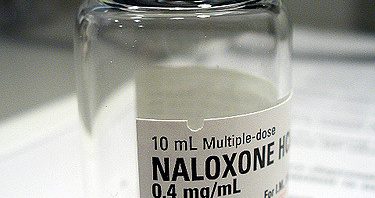Fentanyl. Heroin. Overdose. Opiates. Death.
These words have increasingly littered headlines in the Fargo-Moorhead area in the past year, with fentanyl-laced heroin taking the lives of many in our community. How do opiates work, why are they killing people, and what can we do about it? 
Opiates in the Brain
Opiates – including heroin and fentanyl, but also prescription painkillers like morphine and hydrocodone – work on opiate receptors in the brain and produce euphoric and analgesic effects.
When the drugs enter the body, they cross the blood brain barrier and enter the brain. The euphoria comes from activating opiate receptors in the part of the brain called the nucleus accumbens, which leads to release of dopamine, causing the “high” characteristic of these drugs.
The potency of the opiate determines the level of the high. Heroin is 2-4 times more potent than morphine, and fentanyl is 25-50 times more potent than heroin! The drugs all bind to opiate receptors in the same way, so the potency is determined by how quickly the drug can cross the blood-brain barrier and bind to the receptors.
People abuse opiates for the high, but euphoria isn’t the only effect. There are opiate receptors all over the brain and body, so other systems of the body are affected. And here, too, the potency of the drug determines the strength of its effect. This is where things get deadly. 
Opiates and the Respiratory System
Like I mentioned above, there are opiate receptors all over the body, including the respiratory control center of the brain stem. The opiates bind to their receptors in the brain stem and depress the respiratory center, which can have deadly effects.
When the respiratory center is depressed, it decreases the respiratory rate of the individual and reduces the response to built up carbon dioxide in the body (that feeling when you hold your breath and your chest starts to burn and forces you to breathe). And just like with the euphoria, the effect of this increases from morphine to heroin to fentanyl.
When heroin is laced with fentanyl, like what is happening in the F-M area, people will often take the same amount of the drug, not knowing that it is laced with a much more potent opiate. This leads to depression of the respiratory center that is so extensive that it stops their breathing, and can lead to death if there is not proper intervention.
 Opiate Overdose Intervention
Opiate Overdose Intervention
What is proper intervention, anyway? First of all, anyone in or near the situation of a suspected overdose should call an ambulance.
In the meantime, proper intervention includes Narcan (also called Naloxone), or CPR, or both. CPR helps to deliver oxygen to the body since the person is not breathing on their own.
Narcan is a treatment that can be administered in a variety of ways and reverses the effects of the opiates. It does this by crossing the blood brain barrier, kicking the opiate off of all the opiate receptors, and preventing it from re-activating them for 30-60 minutes.
In the case of Narcan intervention, it is still crucial that somebody calls an ambulance because the overdose effects can return when the Narcan wears off.
The F-M Good Neighbor Project, located in Moorhead, provides Narcan training regularly for anyone in the F-M area, and will send you home with a Narcan kit for a suggested donation of $20. Their events calendar can be found at their website, http://fmgoodneighborproject.com.
